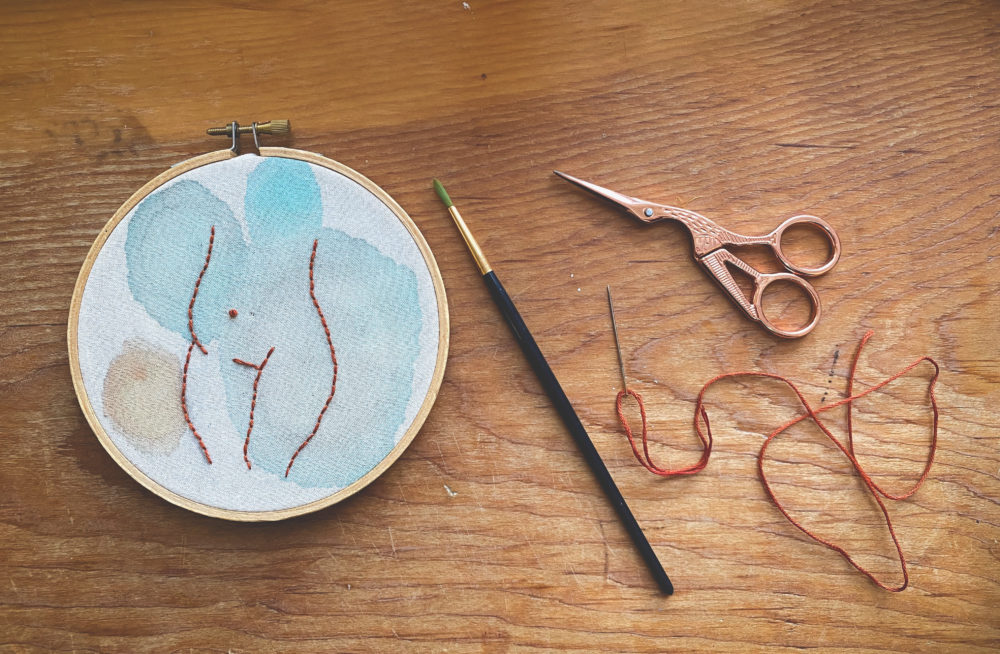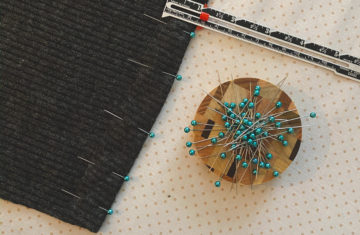This post was supposed to be about a project I finished last week, where I had sewn up a pair of tops that I love. It was supposed to be about how empowered I felt, adding width to the hips of the pattern beyond the upper limit of the sizing that the pattern provided, to make it mine. It was supposed to be about working with that’s available to you, even if it’s a slightly-too-small pattern and how patterns are “just a starting point” anyway, meant to be added to, taken away from, slashed, spread to create a garment that works for your body, no matter what the shape.
To write that post, however, means to admit that there is something about me and my body that needs to be accommodated for. It means having to be the one to do the accommodating.
Before I get into this, I want to say really quick that by no means do I have anything less than the utmost admiration and love for smaller bodies. All our bodies are beautiful. This post is 100%, wholly, and fully about the people who make money from selling sewing patterns and clothing and the capitalist system that they exist under that promotes thinness as a beauty ideal. I also want to acknowledge that while I’m talking about something that makes me feel excluded, there are many many ways in which I am very privileged, and that I don’t and can’t know what it is to be truly oppressed. I just wanted to name this because I think it’s important to talk about inclusivity in sizing but I am doing so from the perspective of a cis-gendered, white female. I think these conversations need to continue to happen in the sewing and fashion community and they need to do so in a way that highlights the intersectionality of body size, gender, sexuality, ethnicity and income.

Last week, a pattern company that had recently come out to say that they wanted to offer more extended sizing for their patterns, released a relatively simple pattern in a size range that was more limited than some of their other patterns. The community reacted in a big way, calling on this company to follow-through with its promise to provide more size options. In a follow-up post on Instagram a few days later, they talked about how small their business is, how hard it is to make patterns for larger bodies, and how they just don’t know enough about the plus size market to even begin to be able to start to offer extended sizing. In short, they went back on their commitment to do better on inclusive sizing.
What do these statements signal to people like me, people with larger bodies? They tell us that we are part of some “other market”, as if we don’t want the same things as people who fit nicely into their pattern sizing range. They tell us that we aren’t worth the effort to be included. They tell us the same thing that is clear from what so many clothing companies offer: people with larger bodies can’t expect to express themselves through clothing in the same way as people with smaller bodies can.
To me, these are not new messages. For most of my young life, I flirted with the line between a “normal” size range and the “plus size” range. Shopping for clothes in grade and high school with my friends, I could never really find anything that I liked, that reflected the personal style I was trying to cultivate (minus the period of my life where I only wore unisex-style t-shirts from pop-punk bands), and that fit well. Most of the clothes manufactured for young girls don’t really accommodate for having wider hips and a rounder bum, something I’ve been blessed with for as long as I can remember. Nothing ever looked like it was supposed to on me.
As an adult, things got slightly better, especially as I got into thrift shopping. I always noticed, however, that the selection in lower size ranges at Value Village was much better than that in the extra-large section. Clothes hung behind that little “XL” ring are often much more worn or of worse quality, and there’s just fewer items overall. I still cringe when I see tutorials on Youtube or Pinterest or whatever that encourage people to shop the XL or XXL section for clothes that can be best hacked into smaller garments. Larger bodies already have a hard enough time finding something they like that fits without everyone else shopping our section too.
The sum of my experiences all added up to a whole lot of insecurity about my body. Back then, I was too young to know that it wasn’t me that was the problem but rather, the companies that marketed to young girls who decided that making clothing up to maybe a size 12 or 14 was enough. Looking back, I think most of my attempts at dieting and weight loss were with the aim of losing enough weight that I could look good in the clothes I wanted to look good in. I lived in fear of a future of being limited to shopping at stores with “Plus” in the name. To me, there was so much shame and stigma about crossing over that line from “normal” sizing to “plus” sizing.
Eventually, I got sick and tired of blaming myself and my body for what clothing stores were failing to provide for me. This is a big part of why I got into sewing. The first garment I ever sewed for myself, I sewed it slightly small. I didn’t want to get real with myself about my measurements or the size that it said on the back of the packet and so I picked the size that I usually was in the stores. The garment in question, a really beautiful sleeveless Farrow dress that I wore to a wedding and loved feverishly, fit well enough to wear for one night and I felt so good about it. Even though it was a bit small, I didn’t feel bad for the first time in my life about having to”size up”. I had no emotion about it whatsoever. I just knew that if I was going to spend all this time making something for myself, I better make it for my real body. For the first time in my life, I was practicing compassion for myself instead of defaulting to shame.
Thankfully, many pattern companies have started to really focus on putting out new patterns with extended size ranges. On top of that, many of them are going back and revisiting their old patterns to update the sizing. They are taking the steps needed to make sure that their products are something that a wider range of people can purchase and enjoy. We are also really fortunate in the sewing community to have people who stand up for inclusivity in sizing and spread the message of being worthy of dressing yourself in the clothes you like, no matter what your size. At the start of this journey, I listened to the Sewing Makes You Love Yourself episode of the Love To Sew podcast. Helen and Caroline were so open and so real about their journeys coming to terms with their bodies through sewing and it gave me the courage to start to examine the negative thoughts within myself and to have those conversations with others as well.

Sewing for myself was the beginning of my personal journey toward body love and body acceptance. To this day, it allows me to continually challenge (and sometimes do battle with) all of the thoughts that have been ingrained in my brain that tell me that my body isn’t good enough the way it is. It allows me to honour my body, no matter where it’s at, and to replace judgement with kindness. Because of this, sewing plays a large role in helping me to cultivate self esteem and feel like I am being myself fully in how I present to the world every day.
As a community, we have the power to lift each other up and the responsibility of pushing each other to do better, to educate ourselves when our actions actively exclude people.
Inclusivity in sizing is a key piece to ensuring that this industry does not continue to perpetuate the same ideals that the ready-to-wear fashion industry does. We see that with a lot of pattern companies and makers within the community but there is a lot more work to do. Continuing to have these conversations can be tough and it can take a lot of courage for the first or second person to stand up and say “hey, this is not okay by me”. The fact that some companies still don’t think it’s their responsibility to engage with people who are plus size says something about them, but it says a lot more about the cultures and systems that they are operating within. As we move forward as a community, it’s important for us to keep raising these issues with the hope that one day, businesses in this space stop seeing the divide between “normal” size and “plus” size. Instead, I hope they can look at how they can make their product as accessible as possible to people of all sizes. To me, that just makes good business sense.


